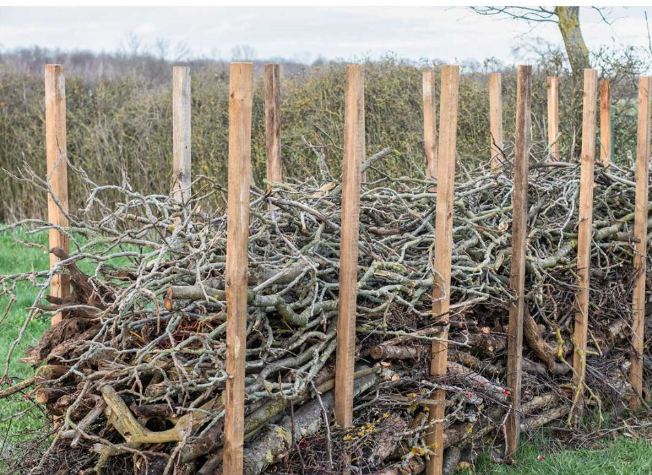The Environmental Impact of Dead Hedges
Dead hedges have a very positive environmental impact for several reasons. First, they actively contribute to waste reduction. By reusing branches and plant debris instead of throwing them away, they help reduce the amount of waste sent to landfills. This recycling of natural materials helps lower the carbon footprint of your garden, as organic materials decomposed by microbes and fungi slowly release carbon back into the soil, instead of contributing to methane emissions in a landfill.
Moreover, dead hedges create microhabitats for a wide range of species. This is especially important in urban or suburban environments where natural habitats are increasingly rare. By providing shelter for birds, insects, and small mammals, you contribute to the local ecological balance and help maintain biodiversity.
Dead hedges also act as windbreaks, which helps reduce soil erosion and promote plant growth. By slowing down wind speed, they limit the movement of soil particles, which is particularly important in areas where soil erosion is a significant issue.
Materials Needed for a Dead Hedge
To build a dead hedge, you will need a few basic materials, mostly natural elements. Here is what you will need:
- Branches and Twigs: The main element of your dead hedge. Branches from deciduous trees like oak, beech, or ash are ideal because they decompose slowly and stay in place for a long time. You will need thick branches for the structure and smaller twigs to fill the gaps.
- Stakes or Posts: To support the structure of the hedge, you will need stakes or posts. These can be made from sturdy branches or wooden posts. Place them at regular intervals to create a stable base.
- Leaves and Plant Debris: You can use fallen leaves and small plant debris to fill the gaps and add thickness to your hedge. This also adds organic matter that will decompose over time.
- Wire or String (Optional): If you want to hold the materials together, you can use wire or string to secure the branches and twigs to the stakes. This is not strictly necessary but can be helpful to ensure the stability of the hedge, especially in the early stages of construction.
Step-by-Step Guide to Building a Dead Hedge
Building a dead hedge is a simple and enjoyable project that you can accomplish with minimal tools. Here are the steps to follow:
Step 1: Choose the Location
Select an appropriate spot for your dead hedge. This could be along a garden boundary, around a vegetable garden, or to create a separation between two areas of your garden. The location should take into account sunlight, wind, and access to water. It is also essential to ensure that the ground is relatively flat and stable.
Step 2: Gather Materials
Collect all the branches, twigs, and other organic materials you will need. Make sure you have enough branches of various sizes to create a solid, stable structure. If you don’t have materials on hand, you can collect them from your garden or ask neighbors or a local gardening center for any excess branches.
Step 3: Prepare the Ground
Before starting construction, prepare the ground by removing any existing vegetation or debris. You can also lightly level the soil if needed to ensure the stability of the structure.
Step 4: Build the Base
Start by driving the stakes or posts into the ground to mark the position of your hedge. Space them 3 to 6 feet apart, depending on the size of your hedge. These stakes will act as supports to hold the branches in place.
Step 5: Stack the Branches
Once the base is in place, begin stacking the thicker branches on the posts to form the main structure. Weave smaller branches and twigs through the gaps to fill in the spaces and add density to the hedge.
Step 6: Add Plant Debris
Complete your hedge by adding fallen leaves, moss, and other plant debris to fill any remaining gaps. This will help to add texture to your dead hedge and encourage organic decomposition.
Step 7: Stabilize the Structure
If needed, use wire or string to hold the materials together. This will ensure that the hedge stays stable and doesn’t collapse under the pressure of wind or rain.
Step 8: Minimal Maintenance
Once your dead hedge is complete, let it take shape naturally. You’ll only need to add materials as decomposition occurs and rearrange it if it starts to lose its shape.
Conclusion
The dead hedge is a practical, aesthetic, and ecological gardening solution. It not only creates a natural barrier for your garden but also promotes biodiversity and recycles plant materials. By reducing waste, providing shelter for wildlife, and preventing soil erosion, it is an excellent choice for those seeking a more sustainable gardening approach. Cost-effective and low-maintenance, the dead hedge is a fantastic option for those wishing to reconnect with traditional gardening practices while making a positive environmental impact.




